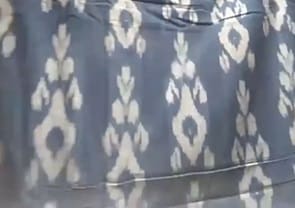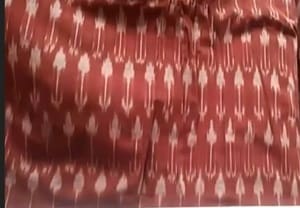Dr Ela Dedhia, Head Department of Textiles & Fashion Technology, College of Home Science Nirmala Niketan, Affiliated to University of Mumbai, India.
A National webinar on HANDLOOM WOVEN FABRIC – JOURNEY WITH IKAT & JAMDANI WEAVERS was held on National Handloom Day, 07th AUGUST 2020, 4 to 5.30pm by the Department of Textile and Fashion Technology, College Home Science, Nirmala Niketan, Affiliated to University of Mumbai, NAAC Accredited A Grade. Delegates included students, teachers, professionals, craft lovers, artisans and others related to this field at National and International level.
Dr. Ela Dedhia, Head of Department of Textile and Fashion Technology, gave an overview of the theme. She said that Weavers are pride of India because since childhood as part of family tradition, the artisans are indulged in learning the art and their mastery produces such fine art pieces of National and International acclaim. Their love and passion for the art and fabric is what brings artisans here on this platform. National handloom day is an auspicious day for all the textiles lover’s and passionate consumers therefore celebrated.
Dr Dedhia moderated the panel discussion including the questions raised by participants on YouTube. She wished all artisans that they will soon come out of the clutches and impact of pandemic.
Along with Dr Dedhia on the organizing committee included Dr. Pratima Goyal, Dr. Vishaka Karnad, Dr. Ritu Madhan, Ms. Neha Mulchandani, Ms. Vrinda Udiaver, Dr. Anjali Srivastav, Ms. Sanghmitra Navalgund and Ms. Vibhuti Khedekar. Edfly was the Technical partner and Textile Value Chain was the Media Partner. Ms. Vibhuti Khedekar proposed the vote of thanks. The webinar was conducted through online video platform and telecasted on YouTube for the audience. The Video is available on YouTube.com/TFTNN.
She welcomed all the participants on YouTube and gave a brief introduction of the panelist.
There were two esteemed panellists during the webinar
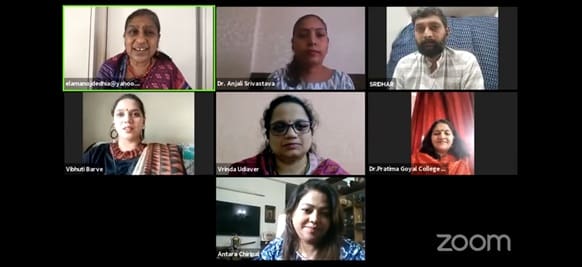
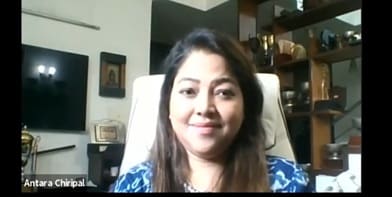 Ms Antara Chiripal Bengali women born & brought up in Kolkata, an MPhil by education, who began her career as an Investment banker for five years, then simultaneously with a boutique for kantha in New Delhi and as her true calling in life was her roots of crafts, she left the job. She has been in touch with Kantha embroiders, specially handmade quilts/godhdis/floormats etc since childhood, made by grandmothers using Kantha but she said that it is very time consuming and laborious and slow process so got interested in handloom weaves so gave it more time and resources for it. She believes that her love for craft she had it in her genes, coming from a Bengali family of artists and poetry. Her aunt Mrs. Mahamaya Sikdar is a President National Award winner for Kantha embroidery so Antara founded Maya weaves along with her. Antara said that her interest to work with artisans didnot come suddenly. The concept of marketing Maya weave products came through having interest for kantha embroidery combined with handloom fabric which Is something that got up the interest in Maya weaves.
Ms Antara Chiripal Bengali women born & brought up in Kolkata, an MPhil by education, who began her career as an Investment banker for five years, then simultaneously with a boutique for kantha in New Delhi and as her true calling in life was her roots of crafts, she left the job. She has been in touch with Kantha embroiders, specially handmade quilts/godhdis/floormats etc since childhood, made by grandmothers using Kantha but she said that it is very time consuming and laborious and slow process so got interested in handloom weaves so gave it more time and resources for it. She believes that her love for craft she had it in her genes, coming from a Bengali family of artists and poetry. Her aunt Mrs. Mahamaya Sikdar is a President National Award winner for Kantha embroidery so Antara founded Maya weaves along with her. Antara said that her interest to work with artisans didnot come suddenly. The concept of marketing Maya weave products came through having interest for kantha embroidery combined with handloom fabric which Is something that got up the interest in Maya weaves.
She said they are associated with many corporates such as Tata, Raymonds and with designers such as Anita Dongre, Raghavendra Rathore, Rohit Bal etc and many exporters and buyers. They exhibit in craft museums, Art museums of state government and state craft houses, kamala craft house, craft shops etc with whom it has been a long association and lot of learning. She has completely enjoyed her journey and has no regrets of leaving the bank corporate job and moving on completely to crafts and fashion.
West Bengal is very famous for muslin since they are very soft. According to her there are 36 varieties of muslin and Jamdani is one of the variety of muslin. There are 64 traditional motifs in Jamdani. Ms Antara experiments various combination of cotton with Marino Wool, Silk and Khadi. Adding many contemporary designs and trying to depict different stories of village scenes, story of Bengal, River, women’s working, animals, forests, etc. Major challenges in production of Jamdani is lack of availability for natural dye, and dyeing facility, therefore having to send to south for dyeing which adds on to the cost. For production majorly Pit loom is used by the artisans. A heavy jamdani such as story telling jamdani takes a longer time to produce a few inches in a day. Whereas simpler jamdani like Buti wali goes sometimes very fast. Hand spun or mill spun yarn are used. A group of women in the organisation works on hand spun yarns. Usually mill spun are used as hand spun gets little expensive. Majorly working with cotton and silk yarns
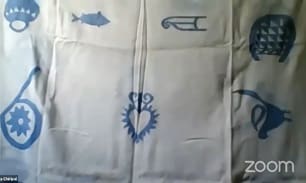
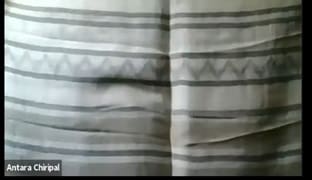
Many people are aware about Jamdani in India. Major market internationally is from Australia, Europe and Japan. Many variations with jamdani products are in demand, such as stole, home furnishings, products like curtain, pillow cover, table mat, table runner, etc. There are few International agents whom they give their products to sell and few international designers who come up with their designs.
Balancing the work with the weavers is a challenge, as she stays at Gurgaon and weavers are in West Bengal. She said weavers are her extended family and she is from one of the weaver’s family. She just sends the PDF of designs and weavers makes it by their own self following it. Other than that her father and aunty are there to look after everything there. Once or twice in a month she goes to Kolkata. As her presence being near the market, it is helpful for her cluster. She has been getting lots of contacts as she is near to market, the buyers can come and see the samples instead of going to the village, There is lots of assurance to the buyers as they don’t have to go back to villages again and again. People in the north India are more into zardozi, Ari work, etc. The understanding is much more there in Mumbai but in Delhi side the awareness about the Jamdani came very late. People are aware about the art but they are more into zardozi. However the market is changing. She showed sarees and samples with village scenes, jungle scenes, river scenes, tedcha (diagonal), phool, etc. She also tries natural dyeing for weft yarns. They use pit looms as there is no electricity involved. They use primitive looms and jacquards also. Intricate Jamdanis per day production is only few inches as insertion of weft is done one by one based on the designs. Mainly they use silk and fine cotton, sometimes add zari.
Mr Sridhar Rao Ikat (Tie and dye of yarns) weaver from a small town called Pochampalli where people came to sell from nearby villages like Nalkonda, Koilagudam etc. Even Hyderabad was a small town then but ikat was being marketed in Pochampalli. He is into producing single Ikat using natural dyeing since his age of 21 years and he is practicing since 22 years. He was pacticing farming but got into this directly. None of the family members were involved in this weaving as they are all traditionally farmers. He is trained by Salimbhai who has trained many. Monthly he produces 1000 to 2000 metres of fabric for which he has employed 25 people only for looms weaving from yarns dyed in natural dyes of which half of them are involved in natural dyeing of yarns also. Weavers set up the warp but the weft he also gets it set outside. They make very simple designs. He is planning double ikat. The traditional Pochampally ikat was woven only into sarees & bed sheets which is said to be brought to the small town of Pochampally from Chirala twice a week on the weekly market days. There was no popularity for the Pochampally Ikat initially. It got its popularity from the traditional labourously produced Telia Rumal and Telia sarees all for local market only but later ikat got popular through exhibitions all over the country. Last ten years its doing well. Initially the Pochampali was produced using Naphthol dyes and there was not much design variation available. With exports growing azo free vat colours became popular. Mr Sridhar came up with natural dyeing with design variations. The main challenge faced by him is Natural dyes had mostly poor colour fastness thus people don’t show interest thinking colours bleed and and colour faded so they don’t buy. Today quality in colouration of Ikat is well developed and Natural dyes are healthy according to him and will bleed a little in the initial wash so he says you cannot compare it with synthetic dyes. He campares with human life and says as we grow old we become duller, same way is natural colours so we have to accept it according to him. However Dr Dedhia explained to him that if applied properly, natural dyes can also be fast to washing, sunlight etc and presently many consumers wash clothes together in washing machines so it is an important quality requirement, which he finally agreed. He further explained that only superficial dye which is on the surface will be washed off and it will not affect any other surface directly, including white fabrics as it requires mordants. He insisted the fabric. He introduced natural in Delhi Craft Council of India. He got very good response. He is working with National Institute of Rural Development for natural dye production. Very few people otherwise in production. Designers, Craftsmen, Dastkar Andhra, does lot of good design development with National Institute of Rural Development. Lot of good workshops also happening there. Currently production and marketing both suffering due to Pandemic.
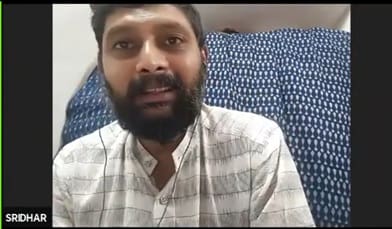
Under the guidance off Salim Bhai he got the Mastery in weaving. With 25 members of natural dyers and weavers, he produces 1000-2000mtrs of work per month depending on the orders majorly making sarees, fabrics and duppattas. He majorly uses cotton yarns. Mr Shridhar sources raw materials from Hyderabad. Convenient to go to Hyderabad and come twice to thrice a week. He wants to produce double Ikat using natural dyes. Domestically there is very good response and internationally Sri Lanka and China have good demand. In lockdown period there was disturbance in income flow but production was high as every artisan has a loom at home. Difficulties was in getting raw material, courier service was slow but marketing was good. There was time to look at old stock too.
This webinar gave detailed information about Jamdani and Pochampali crafts, and also about the diferent challenges faced by the craftsmen due to Pandemic. The session was very enlightening and it briefly touched upon various minute but major factors involved in Handloom with commercial perspective. After the presentation from both the speakers, there was an interactive question and answer session where the questions from YouTube as well as from zoom were answered.
